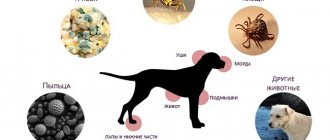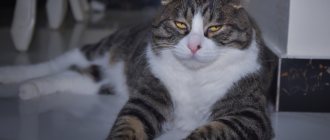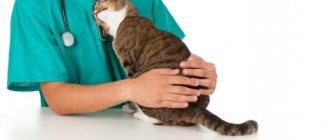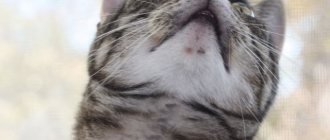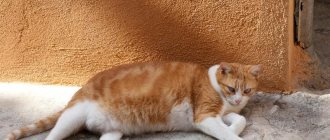Unfortunately, not one cat is immune from the appearance of lichen. The cause of the disease may be pathogenic microorganisms or allergic reactions. In the first case, long-term treatment will be required under the supervision of a veterinarian; in the second, diet correction and elimination of the allergen help.
Any cat can become infected with lichen, but most often young, old or weakened animals are affected. Strong immunity helps the body fight all kinds of diseases, including lichen, but does not protect pets 100%. Even cats that have never left the apartment can get sick, because the infection can be brought from the street on shoes. For the same reason, you should not allow contact with street animals and, upon returning home, wash your hands, clean your shoes and clothes.
Many lovers of four-legged animals simply do not know how to identify the disease and how to treat a cat if it has lichen. But it is important to remember that an accurate diagnosis and treatment can only be prescribed in a veterinary clinic.
Types of lichen in cats
Depending on the cause, there are several types of lichen - pink, multi-colored, weeping or ringworm. Symptoms of manifestation have similar features and sometimes it is possible to distinguish one type from another only in a veterinary clinic. Ringworm is caused by microorganisms such as yeast-like fungi Pityrosporum, Trichophyton (trichophyton), Microsporum gypseum or Microsporum canis. But sometimes the disease develops due to an animal’s allergy to food components, detergents, dust and other irritants to which cats are susceptible.
The incubation period is always different and depends on the general condition of the animal and many associated factors. Fleas, worms, lice and other parasites, as well as any diseases that weaken the body’s natural defenses, can contribute to the development of the disease. Sometimes fungal spores can “sleep” for years on a cat’s fur, in carpet pile, on upholstered furniture and other furnishings.
Ringworm
This type of lichen is considered the most dangerous and difficult to cure. The incubation period lasts on average from 7 to 14 days; in rare cases, the first symptoms may appear on days 20-25. The pathogens are resistant to external influences and can remain active for several years. Once in the soil, the fungus “falls asleep” and is not affected by increases or decreases in temperature, sunlight or humidity. Trichophytosis and microsporia spores are resistant to many chemical disinfectants, so treatment often takes months.
Ringworm is dangerous to humans and is transmitted both through direct contact with a sick animal and through contact with contaminated household items. Therefore, during treatment, veterinarians advise isolating the cat and observing quarantine measures.
A cat can become infected through direct contact with a sick animal, an object inseminated with spores, and while walking in an infected area. The disease can be transmitted by fleas, mosquitoes and other blood-sucking insects, and a cat can also become infected with lichen from rodents.
Cases of latent carriage are quite rare; usually symptoms appear even in cats with strong immunity.
Treatment for lichen is complex and lengthy. In the initial stages, ointments and special shampoos can help; in more severe situations, complex therapy is required. It is highly undesirable to carry out independent treatment and interrupt the prescribed course, since ringworm can “fall asleep” for a while and then reactivate with renewed vigor. All potent medications must be prescribed by a veterinarian.
Ringworm
Ringworm can appear on a cat's body for several reasons. This is usually associated with hormonal disorders or allergies, but sometimes the disease occurs when pathogenic microorganisms are activated. The disease is not transmitted to other animals or humans, but in advanced cases it can cause irreparable harm to the health of the cat.
Characteristic signs of weeping lichen:
- at the beginning of the disease, small pink spots appear on the cat’s skin;
- then the spots on the skin grow and begin to become wet;
- the animal is worried, scratches, licks the affected areas;
- small bubbles with clear liquid form inside the spot; in advanced cases, when an infection occurs, the bubbles are filled with pus;
- the temperature of the affected area is higher than the cat’s body temperature;
- If left untreated, the blisters burst, and the fluid infects healthy tissue, which contributes to the formation of new foci of infection.
With timely treatment, the blisters resolve within 7–14 days. The skin becomes covered with a dense crust, which quickly falls off. Treatment is prescribed by a dermatologist after appropriate tests. Drying ointments with an antibacterial effect are usually used. In severe cases, complicated by inflammatory processes and purulent discharge, antibiotics and restorative drugs are prescribed.
Pityriasis versicolor
Pityriasis versicolor or pityriasis versicolor is caused by the fungus Malassezia (Pityrosporum), which is a resident (normal) skin microbiota. That is, the causative agents of the disease almost always live on the skin and fur of the animal and are activated only when the immune system is weakened. It is possible to become infected with this type of lichen from a cat, but clinical signs will only appear if the person has a weakened immune system or has other concomitant diseases.
Characteristic features:
- irregularly shaped bald patches appear on the skin of animals;
- the skin at the affected sites may be yellow, brownish, pink, white or grayish;
- small spots, if left untreated, gradually merge into large lesions;
- the surface of the spots may be smooth or covered with small scales;
- when it gets on the claws, the fungus deforms the outer and inner layers causing curvature and delamination;
- There is practically no skin itching, so the animal rarely scratches the affected areas.
Ringworm is usually found in warm, moist areas of the animal's body, such as the nose, groin, armpits, ears, and abdomen.
To treat pityriasis versicolor, restorative drugs, antifungal ointment and tablets are prescribed. In advanced cases, treatment can last from 1 to 4 months.
You should also know that lichen versicolor often “falls asleep”, but does not go away completely. Therefore, when immunity is weakened, relapses are possible.
Pityriasis rosea
The causes of pityriasis rosea can be infections or allergies. Usually only weakened animals with poor immunity become infected. Allergic lichen is inherited and may not appear in a healthy cat throughout its life.
Characteristic features:
- small bald spots form on the cat’s neck, back or chin;
- the skin in the lesions turns pink and itches;
- the spots have clear contours, sometimes ridges form on the border of healthy and affected skin;
- combed areas become covered with scabs;
- As the disease progresses, the lesions enlarge and merge.
Treatment should be aimed at restoring immunity. Drug treatment, as with other lichens, is not practiced. When the cat’s condition is normalized, pityriasis rosea goes away in 1–2 months.
If you let the disease take its course, scabs will form in the areas where you scratched. Open wounds from scratching can become infected, causing inflammation and worsening the cat's condition.
The disease is not contagious and does not threaten the health of other pets or humans. An exception may be people or animals with extremely low immunity, but such cases are very rare.
During treatment, you cannot bathe or walk the animal. Water and direct sunlight can aggravate the disease and slow down recovery.
Symptoms of the disease
Although each species is different, they have both common and individual signs of lichen in cats. General symptoms:
- hair loss in areas where the rash appears;
- inflammation, redness, dryness of the epidermis;
- constant severe itching.
Also, each species has separate, characteristic features.
Symptoms of ringworm
If your pet has contracted ringworm, there are several ways to identify it. Some parts of the fur will quickly fall out, but the rest of the coat will remain unharmed. Before this, the development of a small red rash on the body will begin. Because of them, the cat may itch for a long time. Often he finds no rest or suddenly wakes up from an attack of itching.
More developed lichen in cats can be determined by the following signs:
- the cat develops round spots covered with a crust of flaky skin;
- These areas are not covered with hair, and the hairs nearby thin out and become more brittle;
- if during the scratching process the cat scratches off part of the crust, a red smooth surface will be visible under it;
- over time, the spots increase in size and take on an oval or round shape;
- If the disease is not treated for a long time, hair will no longer grow at the sites of inflammation, as hard scabs will form.
The spots often cause discomfort and itch for animals. Depending on the pathogen, symptoms can affect the pet’s entire body or the head and neck separately. It also happens that some signs of lichen in cats are simply not expressed or are completely absent. This is called the apathetic form of the disease. In this case, only some hairs of the coat are susceptible to loss. Because of this, the disease becomes invisible to the naked eye, which means that the owner may not take any action to treat it for a long time.
Symptoms of pityriasis versicolor
Pityriasis versicolor in cats are pale, oval-shaped spots on the animal’s skin. They quickly spread throughout the body and after a few days occupy most of it. Then the spots begin to grow together, which can cause damage and deformation of the claws. In this case, the cat does not feel itching or any other severe discomfort. The spots may disappear if the surrounding temperature drops.
Symptoms of pityriasis rosea
Sometimes feline pityriasis rosea is confused with an allergy. The fact is that it appears as a small red rash on the skin. In some cases, the spots increase to 2 cm in diameter. A large accumulation of them is usually noticed on the pet’s stomach, in the groin and on the inside of the thigh. Itching is absent or almost not expressed.
The skin on which the spots appear becomes rough. If treatment has not begun for a long time, other microorganisms enter the lesions, which causes much more dangerous consequences, for example, sepsis. In some animals this is accompanied by fever, malaise, joint pain and swollen lymph nodes.
Signs of eczema
Weeping eczema is also characterized by red spots. But in this case, it hurts the pet when anything touches the lesions. The rash is small blisters with fluid inside. Sometimes they open, causing their contents to fall onto the surface of the skin. This is how infection and spread of the disease occurs. And although people should not be afraid of this disease, it sometimes causes febrile conditions in pets.
What does ringworm look like in cats?
It is difficult to distinguish lichen from other skin diseases, but it is possible. First of all, it is worth excluding allergic scratching, severe parasitic infestations, injuries, burns and dermatitis.
Ringworm:
- bald spots with jagged edges appear on the cat’s body;
- the location is not clear, the hair around the lesion is brittle and heterogeneous;
- the skin at the site of the lesion is smooth, scratches or scabs are rarely visible.
Ringworm:
- small spots appear on the cat’s skin and grow rapidly;
- bubbles with clear liquid form in the lesions;
- lichen is accompanied by itching, so the animal scratches the affected areas;
- with secondary infection, purulent discharge appears;
- the skin and fur around the fire are moist.
Pityriasis versicolor:
- one or more multi-colored areas without fur are noticeable on the skin;
- the color of the spots may be yellowish, gray, brown or white;
- the skin is smooth or covered with small scales.
Pityriasis rosea:
- lesions from 0.5 to 2 cm;
- smooth outline, pink skin;
- When scratched, scabs form.
For a more accurate diagnosis, you need to contact a veterinary clinic.
Diagnostics in a veterinary clinic
Only a doctor can make a diagnosis based on an examination of the animal and the necessary diagnostic tests. Since lichen disguises itself as other skin diseases, it is important to differentiate it from scabies, allergies, subcutaneous mites, and flea dermatitis.
The main diagnostic method for suspected lichen is to illuminate the affected area with a Wood's lamp. The goal is to identify pathogenic microorganisms on the surface of the dermis. When exposed to the lamp's rays, the fungi emit a fluorescent glow. However, it should be noted that this method is not informative enough. Its reliability is no more than 60%.
A more reliable method is skin scraping. The biomaterial being studied is crusts and scales from the affected areas.
Symptoms and how to identify ringworm in a cat
Depending on the nature of the disease and the course of the disease, clinical signs may vary. But the main external sign of deprivation is rounded bald patches.
The first symptoms of lichen in a cat may appear as early as four days after contact with an infected animal or object. In four-legged animals with strong immunity, signs of the disease can be detected only after several months, and the clinical picture is often blurred without pronounced symptoms.
Main (general) features:
- localized baldness;
- skin pigmentation;
- inflammation, redness, whitish coating;
- increased local temperature;
- peeling, scaliness;
- itching, pain reactions;
- bubbles with clear or yellowish-green liquid at the site of bald patches;
- an inflamed ridge along the border of healthy skin;
- scabs, scratches, matted fur.
Veterinarians recommend regular preventive examinations of cats. Owners should consult a doctor if the cat is constantly itching, nervous, has trouble eating, or does not play its usual games.
Sometimes the disease occurs secretly without the appearance of external symptoms. Accordingly, the owner does not suspect anything, since, at first glance, nothing bothers the cat. With this course, the disease often becomes chronic and difficult to treat.
Typically, the chronic form develops when infection enters from the external environment through contact with infected animals. Often found in long-haired pets, as well as cats with strong immunity and good heredity.
Possible complications
If left untreated, lichen takes on a chronic form, from which the cat will suffer for the rest of its life. The affected areas fester, become inflamed, and subsequently the skin and lymphatic tissues suffer.
In other cases, microsporia is not dangerous. It does not affect internal organs, does not have a negative effect on reproductive function and does not limit the furry’s mobility after recovery.
After treatment for lichen, the cat is left with unaesthetic scars, pigmentation and bald patches on the affected areas of the dermis. However, these are just cosmetic flaws that do not cause concern to the four-legged pet.
Determination of ringworm with a Wood's lamp
Most types of lichen caused by fungus are determined using a Wood's lamp. The spores glow under the lamp with a bright green fluorescent color. The cat is brought into a dark room and ultraviolet light is directed at it.
Before the procedure, you should not treat the affected areas with ointments or powders, as this may complicate the diagnosis. The fact is that some medications also glow green when exposed to ultraviolet light.
You should also know that not all types of fungus can be determined using a Wood's lamp. For some species, you will have to take an analysis and do a culture. This method gives almost 100% results, but takes from several weeks to a month, since the spores grow for a very long time.
Diagnosis of ringworm
Due to the similarity of microsporia with other diseases, the final diagnosis is made only by a veterinarian after a special examination.
First of all, the study is carried out with ultraviolet rays using a lamp with a Wood filter. Areas affected by microsporia give an emerald green glow.
However, this method does not give a 100% result. The recent application of medicinal ointment, iodine or brilliant green to the lesions can blur the picture.
Then, to clarify the diagnosis, the doctor will conduct additional tests and then prescribe treatment.Effective drugs for treating lichen in cats
At the first symptoms of lichen, you should contact a veterinary clinic. The doctor will conduct the necessary tests, take samples, make a diagnosis and prescribe treatment. Self-medication is extremely undesirable, as there is a risk of simply “healing” the cat. It should also be remembered that fungal forms often go into long-term hibernation and will appear again when the immune system is weakened.
At the initial stage, topical drugs are usually used. Various ointments and sprays that help relieve itching, inflammation and eliminate fungal lesions.
In more complex cases, local therapy is combined with oral antifungal drugs.
Tablet antifungal drugs:
- Griseofulvin;
- Intraconazole;
- Terbinafine;
- Veto Wedge;
- Ketoconazole.
In addition to antifungal drugs, a veterinary dermatologist must prescribe immunostimulants, vitamin and mineral complexes, and also give recommendations on feeding and keeping the cat.
The reaction of pets to the use of drugs is always different and depends not only on the individual susceptibility of the animal, but also on the type of lichen. Therefore, the course of treatment is prescribed individually for each cat.
The course of taking individual medications for lichen, as well as the use of ointments, can last from 2 weeks to several months. You cannot interrupt treatment on your own, since untreated lichen will relapse as soon as you stop taking the medications.
During the treatment process, it is necessary to visit the attending physician so that he can examine the cat, track the dynamics and, if necessary, make course adjustments.
Vaccination:
- Vakderm F;
- Microderm;
- Polivak-TM.
Along with other medications, veterinarians often prescribe vaccinations. In Russia, lichen vaccines are used for both treatment and prevention.
Symptoms
suspect lichen by how often the cat begins to itch, and the hair in the affected area loses its shine and begins to fall out. These signs accompany all forms of the pathological process, but based on individual symptoms, veterinarians and experienced cat owners can recognize exactly what form of the disease their pet has.
Shearer
The first sign of ringworm is restlessness and constant scratching by the cat in one area. If you part the fur and look closely, you will notice small flaky spots covered with crusts on the skin. The hair above them begins to fall out, and reddish skin is visible in the bald areas. Without treatment for ringworm in cats, the patches become covered with gray scabs and spread throughout the body.
Pityriasis
With pityriasis versicolor, only a small, pale, oval-shaped spot is noticeable on the affected area. After a few days, it increases in size, merges with neighboring ones, forming large lesions. If a cat's paw is infected with lichen, the infection can spread to the claw and cause its deformation. With pityriasis versicolor, the itching practically does not bother the cat; the spots can disappear on their own when the ambient temperature drops.
Pink
Pink ringworm of cats is accompanied by the appearance of pink round spots with a diameter of 1.5-2. Most often they affect the abdomen, groin area, and inner thighs. Itching is very mild or absent. The spots in the center are smooth, but flaky along the edges. Without treatment, they can become infected and lead to fever, joint pain, and inflammation of the lymph nodes.
Weeping
Red spots with small blisters that appear at the initial stage of lichen lichen are very painful when touched. The skin around the spots is hot. The bubbles are filled with liquid, which, when the reservoir ruptures, spills out and infects healthy tissue. A crust forms at the site of the burst bubble.
How to treat ringworm in cats at home
At home, only pityriasis rosea or pityriasis versicolor can be treated in the early stages. Traditional methods are not very effective in treating ringworm or weeping lichen, but are justified if the cat has contraindications to drug treatment.
Folk remedies:
- aloe juice with olive oil in a 1:1 ratio;
- celandine for treating wounds;
- iodine solution;
- a mixture of warm lemon juice and olive oil. Used in the form of compresses.
All of the methods listed cannot give a 100% guarantee, so you should contact a veterinary clinic as soon as possible.
Where does it most often appear?
Usually the disease is localized on the head, ears, muzzle of the animal, on its limbs or tail.
By scratching the infected areas, the cat spreads the infection throughout the body - if treatment is not started in time, the disease will spread over most of the animal's skin.
Perhaps the cat does not have lichen, but baldness.
Diagnosis of the disease
If you have any skin diseases or suspicion of ringworm in your pet cat, you should immediately take your pet to a veterinarian. Only a specialist can diagnose the pathology and prescribe the correct treatment.
What does ringworm look like in cats?
Above the eye
Behind the ear
Photo - what lichen on a cat's back looks like.
In a veterinary clinic, the diagnosis is confirmed using fluorescent (under a lamp), microscopic and cultural (bacterial culture) studies.
Ointment for ringworm in cats
To treat lichen in cats, complex therapy is used, which necessarily includes ointments. But all appointments must be coordinated with a veterinarian after tests and tests. Some components can only aggravate the situation, and the use of drugs before diagnosis can blur the picture.
Before treatment, the affected areas are washed with a cotton swab or disk soaked in warm water or chlorhexidine. Remove scabs and crusts, and also clean adjacent fur. In some cases, the hair around the spot is cut off. The affected area is dried and only then the ointment is applied, covering healthy areas by 1–2 cm.
Clotrimazole has anti-inflammatory and antifungal effects and is used to treat affected areas of the skin with weeping and ringworm. The ointment is applied in a thin layer to the skin two or three times a day. The course of treatment is at least a week; if necessary, the drug is used for 2–3 weeks. Repeated treatments are recommended after three weeks.
Sulfur ointment is used in the treatment of various forms of lichen. A small amount of ointment is applied to the affected skin, covering 1–2 cm of healthy skin. The course of treatment is from 10 to 20 days.
YAM BK ointment has a pronounced antifungal and antiseptic effect. The drug is applied to the skin in a thin layer (it is not necessary to remove crusts and scabs) 1-2 times a day for a week. In case of relapses, the course of treatment is repeated.
Terbinafine is used to treat fungal skin diseases caused by dermatophytes and lichen versicolor. The ointment is applied to the affected areas 2-3 times a day for 10-14 days. If necessary, the course is repeated after 14 days.
When using any ointments, it is necessary to protect the animal. Cats often lick medications, so you need to use a special collar.
Local preparations
Typically, these drugs are applied to the affected areas of the animal. Since they are not safe for internal use, it is necessary to put a wide collar around the cat’s neck to prevent the pet from licking the medicinal product from the body.
Shampoos
Antifungal shampoos are used to treat lichen in cats. Their action alone will not relieve a meowing pet from the disease; it should only be used in a comprehensive manner. It is also not recommended to mix anti-lichen shampoos with regular shampoos.
Nizoral and Sebozol are considered good ones. They contain Ketoconazole, which is excellent against various fungi, infections and bacteria. It is necessary to wash your pet with shampoo 2 times a week for 1.5-2 months.
Ointments, sprays, creams
There are many liquid preparations that help fight lichen in cats, the treatment of which has long been neglected. Before using any ointments, sprays or creams, the animal's skin must first be prepared by cutting short the hair around the lichen spot.
To cure ringworm in a cat, it is recommended to use ointments that contain Clotrimazole. It perfectly helps get rid of fungi, although its use will last at least a month. More advanced products with his participation are Sanoderm and Fungin. Their action heals wounds, relieves inflammation and itching.
The drug Miconazole has a good bactericidal effect. By rubbing it into your pet's skin, it destroys lichen fungi. Yam BC ointment also helps eliminate various dermatological diseases, including ringworm.
But Imaverol can be used to treat lichen in pregnant cats and kittens.
A good option for getting rid of lichen would be sulfur and salicylic ointments.
The affected areas of the skin are lubricated generously with ointment twice a day. The advantage of these drugs is their low cost.
Ringworm from cats to humans and children
Not all types of lichen are contagious, so before you panic, you need to find out what kind of disease has affected your pet. Contagious include ringworm and, to a lesser extent, tinea versicolor. The rest are practically not dangerous for adults, children and other pets.
You can become infected with ringworm through direct contact with a sick animal or object. It is important to remember that fungal spores are quite tenacious, so they can “sleep” for years in the soil, on clothes, wool or furnishings.
A cat can catch lichen by playing on the street where a sick animal has passed, from common care items, bowls or toys. Fungal spores can be found in skin flakes, hair follicles or dandruff.
The disease usually affects older people, children, and people with weakened immune systems.
Wounds, eczema, dermatitis and other skin defects can provoke infection into the human body.
After the first symptoms of the disease appear, you must immediately consult a doctor and take the cat to an appointment with a veterinarian. Timely treatment will help stop lichen at an early stage and prevent the disease from spreading. It is important to observe quarantine measures and prevent contact between infected and healthy people and animals.
Causes of infection
A domestic cat that does not leave the apartment is least likely to become infected. Ringworm is usually found in animals that are allowed outside.
The most common causes of the disease:
- direct contact with rodents, which are the main carriers of this disease;
- interaction with another animal (cat or dog) that is already infected or is still only carrying fungal spores;
- remnants of fungal spores on furniture, carpets and other surfaces of the house that were not treated after treatment of ringworm.
In adult healthy animals, in most cases, there is genetically determined resistance to this disease. Weakened immunity and advanced age increase the risk of lichen.
Disease prevention
Veterinarians recommend avoiding any contact with foreign animals, and also thoroughly washing your hands after going outside. It is necessary to clean clothes, shoes, clean the apartment with special disinfectants, and also do not skip preventive examinations of the cat at the veterinary clinic.
It is recommended to wash your paws after every walk, even in a relatively safe area. Solutions of chlorhexidine and miramistin help well; they are safe for cats, but harmful to fungal spores.
It is important to monitor the health of your beloved cat and not skip vaccinations. But before using the vaccine, you must consult a doctor, as there are contraindications. The pet's diet should be balanced and nutritious.
Basically, all preventive measures are aimed at maintaining health and developing strong immunity in the cat. It is important to remember that a healthy animal gets sick much less often, and a strong body successfully resists almost any external influences of pathogenic microflora.
Are traditional methods of treatment allowed?
Considering that a fungal infection causes lichen in cats, treatment cannot be based solely on lotions, rubbing with herbal tinctures and other methods with questionable effectiveness. Folk remedies can be used as an additional measure to enhance the effect of medical therapy.
Your task is to adhere to the prescribed treatment regimen, especially since drugs for external and internal use are inexpensive.
Tags
in cats and in cats and in infected cats and in cats and in cats generalized cats and in cats it is necessary to feed Feeding dogs Feeding cats Feeding rodents Feeding birds Feeding dogs Feeding cats Feeding rodents Feeding birds Feeding dogs Cats treat cats themselves. The type of disease is not dangerous for the disease.
dry stockspeoplecareconditionsproductsvitaminsskiveterinary fleasmore detailsmitebirdstoilet



